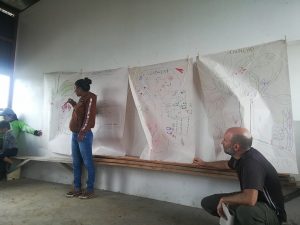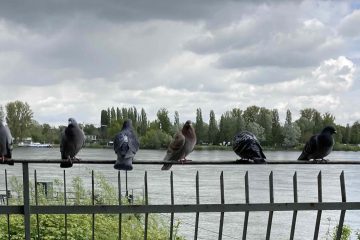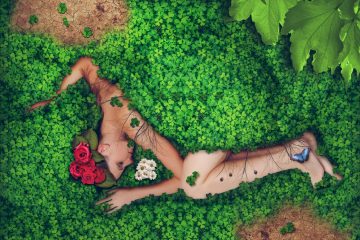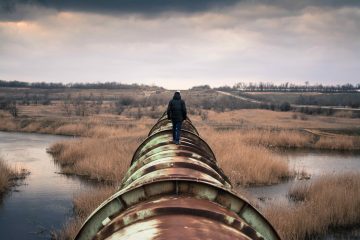Indigenous Cosmovision Challenges Us to Move from Restoring to “Re-storying” Ecosystems
By Daniel Bryan

Recently, I accompanied a Humans for Abundance team to the community of Mushullakta with master ecosystem restorer, Omar Tello.
In a workshop on interconnecting cultural traditions to ecosystem restoration, we defined the community’s ecosystem as a triangulation of the forest that surrounds them, the biodiversity that brings life to the forest and the culture of the people living in and with the forest.
The community generously listened, yet it was clear that even though they perfectly understood Spanish, we were not speaking the same language of knowing.
This led me to think: How many times a week do we utter or hear phrases like “I know, I know,” or questions like “How do you know that is true?” They seem like simple interjections into a conversation; however, they also represent deeply seeded assumptions that this blog post seeks to challenge. “Knowing something” is rooted in a way of knowing.
For example, the statement “I know that cutting down the Amazon Rainforest accelerates climate change” likely comes from your trust in knowledge that was produced by the scientific method. You have seen reports, probably even graphs, that show a linkage between disappearing forests and increasing temperatures. Indeed, (almost) all scientific studies suggest that the studies are true, making you feel comfortable when you say “I know.”
For most of my life, certainly during my formal education, I have seen knowledge similarly. I was taught this way of knowing our world and to make decisions based on it. However, is this the only way of knowing our world? Should it be our dominant way of knowing our world? Taking into consideration our whole selves, including our emotions, our bodies, and our relationships, is it even an effective way of communicating knowing?
For twenty years, I have been privileged to work with Indigenous communities in Ecuador, and what they have taught me, more than anything else, is that if we truly want to address the world’s greatest challenges, we must first challenge how we know our world. To explain what I mean, let’s go back to the topic of climate change.
A few years ago, an Indigenous leader and I talked about what we need to do to improve how we teach climate change. I told him about the thousands of studies and doomsday graphs we use in the Western world, and he listened patiently. After I finished, he responded with “and how is that working out for you?”
Feeling defeated, I said, “well, not that great.” That is when he showed me an image of a marvelous painting in which all of nature was alive just as humans are alive.
It showed a woman sitting in a lake beneath the Andes mountains. Her hair fell into the water and continued as an embodiment of a river flowing into a forest. She was looking back up to the mountains and clouds, all of which were also embodied with the faces of traditional Andean musicians.
I remember becoming lost in the picture, because I was not just seeing the images. I was also hearing the music the mountains and clouds were playing. The painting was a song and although I could not name what they were playing, I could hear it.
My friend told me, “For us, climate change is not a series of graphs that are reaching a tipping point. It is the slow disappearance of the song you are hearing. It is losing touch with those feelings that the song brings to you. It is the story of a living energy that is represented by the images and the song all at once.
That is how we know climate change is real. And until all our world feels similar impacts, until this catastrophe truly affects your song, you will not be able to do anything to stop it. Why? Because you really don’t ‘know’ climate change.”
This conversation made me feel that I do not know climate change, yet at the same time, there was a part of me that wanted to discredit his story because it didn’t mesh with how I was taught to value knowledge.
Certainly, our ways of knowing are so deeply ingrained in our way of living that it takes almost no time to classify what knowledge is valuable and trusted versus what knowledge is unsophisticated and inconsequential.
We think we “know” that certain knowledge matters more in the “real world”. Yet, I also cannot help but wonder if the real “real world” will survive our dominant way of knowing.
If we want an earth where our grandchildren will have air to breathe and water to drink, I suggest we all make ourselves vulnerable to alternative ways of knowing this earth that is our home.
Indigenous ways of knowing our world are relational and embodied ways of knowing the living energy that my friend introduced me to. They do not reject Western thinking, but they do denounce the separation of thinking from feeling.
Embodied knowing is “thinking-feeling,” and relational knowing is “with…” Together, embodied and relational ways of knowing our world are “thinking-feeling with the world.”
For this reason, you may hear Indigenous peoples give praise, thanks, and recognition to “all my relations,” which includes the mountains, rivers, forests, and sky.
Learning new ways of knowing is a process that asks us to continuously question our assumptions.
In Mushullakta, we questioned our assumptions by realizing we were not speaking the same ‘language of knowing,’ and on a break we asked the leaders to help define the word “ecosystem” in Kichwa and according to how they perceive it. Their answer was simple and affirming. “Ecosystem is ñucanchik kawsay,” which means “our living energy.”
In hearing their deeply moving words, I was transported back to the painting my friend showed me almost a decade earlier. With the community’s guidance, I stopped thinking about restoring a system and I began to think about “re-storying” a living energy into our lives.
If we truly hope to end deforestation and take on climate change, it is time to reimagine “restoring” as “re-storying.”
We need to observe our world as if our natural surroundings are alive and primary characters in our story; we also need to see the land as if it were our bodies. The trees are our ancestors as much as our great-grandparents are, the rivers flow through the lands as blood flows through our veins, and the mountains and clouds sing us songs similar to the ones we sing to our own children.
Re-storying is making sense of the world. We still “make sense” out of it by seeing those graphs, but we also “make ourselves sense” that the world is part of us and we are part of it.
#
Daniel Bryan is an educator, activist, and artist. He is the co-founder and Director of the Pachaysana Institute, a non-profit educational organization dedicated to community-based, fair-trade, intercultural education programs in Ecuador.
Counterpoint blogs may be reprinted with the following acknowledgement: “This article was published by Counterpoint Navigating Knowledge on 9 December 2020.”
The views and opinions expressed on this website, in its publications, and in comments made in response to the site and publications are those of the author(s) and do not necessarily reflect the views and opinions of Counterpoint: Navigating Knowledge, its founders, its staff, or any agent or institution affiliated with it, nor those of the institution(s) with which the author is affiliated. Counterpoint exists to promote vigorous debate within and across knowledge systems and therefore publishes a wide variety of views and opinions in the interests of open conversation and dialogue.
This text is a republication of a contribution to Humans for Abundance on 30 October 2020.
Photo credits: © Pachaysana Institute 2020



